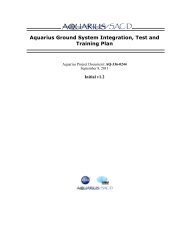NASA Goddard Space Flight Center Ocean Data Processing System ...
NASA Goddard Space Flight Center Ocean Data Processing System ...
NASA Goddard Space Flight Center Ocean Data Processing System ...
You also want an ePaper? Increase the reach of your titles
YUMPU automatically turns print PDFs into web optimized ePapers that Google loves.
<strong>NASA</strong> <strong>Goddard</strong> <strong>Space</strong> <strong>Flight</strong> <strong>Center</strong> <strong>Ocean</strong> <strong>Data</strong> <strong>Processing</strong> <strong>System</strong>Operations, Project <strong>Data</strong> and Software Management PlanSeptember 20101.0 INTRODUCTIONThis document describes the Operations and Project <strong>Data</strong> Management Plan (PDMP) for the<strong>Ocean</strong> <strong>Data</strong> <strong>Processing</strong> <strong>System</strong> (ODPS) at the <strong>NASA</strong> <strong>Goddard</strong> <strong>Space</strong> <strong>Flight</strong> <strong>Center</strong> (GSFC).The ODPS performs scientific data acquisition, processing, archiving and distribution for severalpast and current ocean remote sensing satellite sensors, and will also be supporting future sensorsas well. Each supported mission and sensor is summarized in Section 2 below.1.1 Purpose and ScopeThis data management plan describes the acquisition, generation, management and distributionof science data products generated by the ODPS. Covered in this plan are:• Brief description of the programs and sensors• Generic operations concept an mission-unique features and responsibilities.• Description of the data flows• Description of the science data products• <strong>Data</strong> availability and distribution policies1.2 PDMP Development, Maintenance, and Management ResponsibilityThe <strong>Ocean</strong> Biology <strong>Processing</strong> Group (OBPG) within the GSFC <strong>Ocean</strong>s Branch, Code 614.2, isresponsible for the development, maintenance, and management of the ODPS PDMP. TheODPS Manager, Dr. Gene C. Feldman, has overall responsibility for the plan, and will havespecific responsibility for approving any changes to the plan.
2.0 MISSION AND SENSOR OVERVIEWThe ODPS supports the following past, present and future missions and sensors, listed inchronological order by launch date.• Nimbus-7 Coastal Zone Color Scanner (CZCS)• Advanced Earth Observing Satellite (ADEOS) <strong>Ocean</strong> Color and Temperature Scanner(OCTS)• OrbView-2 (OV-2) Sea-viewing Wide Field-of-view Sensor (SeaWiFS)• Terra Moderate Resolution Imaging Spectroradiometer (MODIS) and Aqua MODIS• Satelite de Aplicaciones Científicas D (SAC-D) Aquarius• National Polar-orbiting Operational Environmental Satellite <strong>System</strong> (NPOESS)Preparatory Project (NPP) Visible and Infrared Imager Radiometer Suite (VIIRS)Each mission and sensor is summarized in the following sections.2.1 Nimbus-7 CZCSThe Nimbus-7 satellite was the last in a series of Earth remote sensing mission launched by<strong>NASA</strong> in the 1960’s and 1970’s. The mission is summarized in Table 1.Table 2-1 – Nimbus-7 Mission SummaryLaunch Date October 25, 1978Orbit TypePolar Sun-synchronousAltitude (nominal)955 kmEquator crossing time/direction 12 noon ascendingOrbit Period~104 minutesCZCS was the first satellite-based ocean color sensor, and was flown on Nimbus-7 as a proof-ofconceptexperiment. The onboard data storage was limited, and data collection was scheduledover designated locations. <strong>Data</strong> collection spanned nearly eight years, from October 30, 1978 toJune 22, 1986. The instrument was officially declared dead on December 18, 1986.Table 2-2 – CZCS SummaryInstrument TypeResolutionBands/channelsSwath widthSensor OutputTiltCross-track scanning spectrometer825 m6 bands, 443 nm to 11.5 microns1556 km8 bit, single gain-20 to +20 degrees
2.2 ADEOS OCTSADEOS was launched and operated by the Japanese space agency (then NASDA, now JAXA).It was designed for a multi-year mission but suffered a fatal spacecraft control failure after ninemonths of operations.Table 2-3 – ADEOS Mission SummaryLaunch Date August 17, 1996Orbit TypePolar Sun-synchronousAltitude (nominal)800 kmEquator crossing time/direction 10:30 AM descendingOrbit Period101 minutesOCTS included bands for both ocean color (visible/NIR) and thermal IR measurements. Itcollected global ocean data from November 1, 1996 to the spacecraft failure on. June 30, 1997.Table 2-4 – OCTS SummaryInstrument TypeResolutionBands/channelsSwath widthSensor OutputTiltCross-track scanning radiometer700 m12 bands, 412 nm to 12.5 microns1400 km10 bit, single gain0, +/- 20 degrees2.3 OV-2 SeaWiFSOrbView-2 was launched and initially operated by Orbital Sciences Corporation (OSC). Theownership and operations were transferred to ORBIMAGE, a subsidiary of OSC, in 1998, andORBIMAGE became GeoEye in 2006. OV-2 was designed for a five-year mission, andcontinues to operate nominally.Table 2-5 – OV-2 Mission SummaryLaunch Date August 1, 1997Orbit TypePolar Sun-synchronousAltitude (nominal)705 kmEquator crossing time/direction 12 noon descending (at launch)*Orbit Period~99 minutes*The orbit has not been maintained, and the crossing time has drifted into the afternoon.SeaWiFS was the first sensor designed to support global ocean color data collection, although itwas preceded into orbit by OCTS. Routine data collection was started on September 18, 1997.Global Area Coverage (GAC) data, which are recorded globally, are subsampled at 4x4 from the
full-resolution sensor data, and also truncated at the start and end of the scan. Local AreaCoverage (LAC) data are collected at full resolution, and recorded in limited quantities overselected targets; full-resolution are also direct-broadcast to ground stations in High ResolutionPicture Transmission (HRPT) format. The sensor continues to operate normally with noapparent problems.Table 2-6 – SeaWiFS SummaryInstrument TypeResolutionBands/channelsSwath widthSensor OutputTiltCross-track scanning radiometer1.1 km8 bands, 412 to 865 nm1500 km (GAC), 2800 km (LAC)10 bit, bilinear gain0, +/- 20 degrees2.4 Terra and Aqua MODISTerra and Aqua were the first two (of three, the third being Aura) large Earth Observing <strong>System</strong>(EOS) satellites launched and operated by <strong>NASA</strong>. Both EOS missions are multi-sensor andmulti-disciplinary, and continue to operate without significant problems.Table 2-7 – Terra Mission SummaryLaunch Date December 18, 1999Orbit TypePolar Sun-synchronousAltitude (nominal)705 kmEquator crossing time/direction 10:30 AM descendingOrbit Period98.9 minutes*Table 2-8 – Aqua Mission SummaryLaunch Date May 4, 2002Orbit TypePolar Sun-synchronousAltitude (nominal)705 kmEquator crossing time/direction 1:30 PM ascendingOrbit Period98.9 minutes** Maintains 16-day repeat cycleThe MODIS instruments flown on Terra and Aqua were of identical designs. Terra MODIS wasdesignated the proto-flight model (PFM) and started data collection on February 24, 2000; AquaMODIS was designed <strong>Flight</strong> Unit 1 and started data collection on July 3, 2002. MODIS supportsmultidisciplinary (ocean, land and atmosphere) data product generation. Both instrumentscontinue to operate nominally.
Table 2-9 – MODIS SummaryInstrument TypeResolutionBands/channelsSwath widthSensor OutputTiltCross-track scanning radiometer1 km, 500 m and 250 m36 bands, 412 nm to 14 micron2300 km12 bit, single gainNone2.5 SAC-D AquariusSAC-D will be the fourth scientific satellite built by Comision Nacional de ActividadesEspaciales (CONAE) in Argentina. CONAE is headquartered in Buenos Aires, and the MissionOperations <strong>Center</strong> is located in Cordoba. SAC-D will be launched by <strong>NASA</strong>, but will beoperated by CONAE. The payload will also include seven science instruments developed byCONAE and other agencies.Table 2-10 – SAC-D Mission SummaryLaunch Date (planned) April, 2011Orbit TypePolar Sun-synchronousAltitude (nominal)657 kmEquator crossing time/direction 6:00 PM ascendingOrbit Period98 minutes** Maintains 7-day repeat cycleThe Aquarius instrument is the first satellite-based ocean salinity sensor. It is being built by<strong>NASA</strong> and will be flown on SAC-D. Aquarius combines a passive radiometer with an activepulsed radar scatterometer, which share the same optics (feed horns and antenna). Theradiometer is being built at GSFC, and the scatterometer, overall integration and Projectmanagement are located at the <strong>NASA</strong> Jet Propulsion Laboratory (JPL).Table 2-11 – Aquarius Radiometer SummaryInstrument TypeResolutionBands/channelsSwath widthSensor OutputViewPassive microwave polarimeter~100 km1.413 GHz, three feed horns withfour polarization states each~400 km16 bitBoresights 25.8 to 40.3 degrees offnadir (fixed), ~6.5 degree beam size
Table 2-12 – Aquarius Scatterometer SummaryInstrument TypeResolutionBands/channelsSwath widthSensor OutputViewActive radar scatterometer~100 km1.26 GHz, three feed horns withfour polarization states each~400 km16 bitBoresights 25.8 to 40.3 degrees offnadir (fixed), ~6.5 degree beam size2.6 NPP VIIRSThe NPP satellite is being built and launched by <strong>NASA</strong> as a risk reduction mission for NPOESS.Oversight for NPOESS is provide by a tri-agency Integrated Program Office (IPO), which isjointly managed by the National <strong>Ocean</strong>ic and Atmospheric Administration (NOAA), theDepartment of Defence (DoD), and <strong>NASA</strong>. NPP will carry four other sensors besides VIIRS.Following launch, it will be operated by the NPOESS Shared <strong>System</strong> PerformanceResponsibility (SSPR) contractor, Northrop Grumman <strong>Space</strong> Technology (NGST), from aNOAA facility.Table 2-13 – NPP Mission SummaryLaunch Date (planned) October, 2011Orbit TypePolar Sun-synchronousAltitude (nominal)830 kmEquator crossing time/direction 1:30 PM ascendingOrbit Period101.6 minutesVIIRS will be flown on every NPOESS satellite as well as on NPP. It is conceptually similar toMODIS, with comparable resolution, spectral coverage and support for multidisciplinary dataproduct generation.Table 2-14 – VIIRS SummaryInstrument TypeResolutionBands/channelsSwath widthSensor outputTiltCross-track scanning radiometer750 m and 375 m22 bands, 412 nm to 12 micron3040 km12 bit, dual/single gainNone
3.0 ODPS DATA PROCESSING3.1 Project-wide <strong>Processing</strong>This section describes the ODPS activities that are common to all missions and sensors. Anoverview of the <strong>Data</strong> <strong>Processing</strong> is provided, followed by descriptions of <strong>Data</strong> Archive andManagement, <strong>Data</strong> Distribution, and Software Configuration Management.3.1.1 <strong>Data</strong> <strong>Processing</strong> OverviewThe data processing for all sensor data within the ODPS is similar in nature. All data processingand management is controlled by non-mission-specific process scheduling and data managementcomponents. These comprise a fully automated, distributed data system for acquiring,processing, archiving, and distributing scientific data. The system is highly scalable and easilyadaptable to support multiple concurrent missions. The following subsections describe theODPS scheduling and archiving system and the science data processing software.Scheduling and Archiving <strong>System</strong>The components of the ODPS are: the Scheduler/Visual <strong>Data</strong>base Cookbook (VDC), the ArchiveDevice Manager (ADM), <strong>Data</strong> Acquisition and Ingest, File Migration and Management, and<strong>Data</strong> Distribution. The last two will be described in other sections.• The Scheduler/VDC runs in a daemon-like state and monitors task records in the to-do listtable. It runs tasks according to defined task attributes. A standard job-shell interface allowsnew programs to be quickly adapted for Scheduler control.VDC uses recipes to encapsulatedata-specific processing schemes and parameters. It defines Virtual <strong>Processing</strong> Units (VPUs)as distinct distributed processing resources. VPUs are dynamically allocated based onavailable time and the current OS load. VDC also supports prioritization of processes andresources.• ADM supports logical pools of storage devices. When processes request a device in aspecific pool, ADM returns information for a storage device in the requested pool. A diskmonitorprocess polls all devices periodically to record usage statistics and invoke thresholdhandlers.• <strong>Data</strong> acquisition and ingest is performed using active, passive, and periodic notificationmethods. The active method scans remote systems for new files and populates the ingestqueue. The passive method waits for arrival of E-mail messages describing type and locationof new file and populates the ingest queue. The periodic method schedules ingests of files atuser-specified intervals.Scientific <strong>Data</strong> <strong>Processing</strong> SoftwareThe data from the various sensors are processed to standard levels as defined by EOS. Theproducts and levels are described more fully in Section 4. The processing steps for all sensors
include: Level-0 to 1A (unpacking), Level-1A to 1B (calibration), Level-1B to 2 (geophysicalparameter retrieval), and Level-2 to 3 (spatial and temporal compositing). At each level, theproducts are stored and cataloged for subsequent retrieval or distribution.The initial processing steps, unpacking and calibration, are sensor-specific, and are determinedby the raw (Level 0) data format and the calibration approach for each sensor. The retrieval andcompositing steps for most sensors and products, i.e., <strong>Ocean</strong> Color and Sea Surface Temperature(SST), are performed using multi-sensor software:• The Multi-sensor Level-1 to Level-2 (MSl12) software performs the geophysicalparameter retrieval. This includes atmospheric correction, determination of surfaceparameters (either normalized water-leaving radiances (nLw) or brightness temperatures),and determination of geophysical values (chlorophyll and optical properties for <strong>Ocean</strong>Color, or temperature for SST). For CZCS and SeaWiFS, the inputs to MSl12 are theLevel-1A (uncalibrated) data, so the processing for these sensors requires the calibrationsand sensor corrections to be applied before the other steps.• The temporal and spatial compositing are performed by the l2bin and l3bin programs.The l2bin software accumulates the geophysical values for a single day into equal-areabins, either 9.2 or 4.6 km in size, and l3bin composites data from multiple days (seeLevel 3 product descriptions below).• The smigen program re-projects the composited binned data into standard mappedimages based on an equi-rectangular (Plate Carré) grid.The Level-2 processing also requires dynamic ancillary data from a number of sources. The dataare common across sensors, but are product-specific. A summary of ODPS ancillary data typesand sources is given in Table 3-1.Table 3-1. Ancillary <strong>Data</strong> Types and Sources<strong>Data</strong> Type Static/ Primary SourceBackup Source(s)DynamicOzone D OMI TOMSClimatology (seasonal)Meteorological D NCEP Climatology (seasonal)SST D Reynolds OISST Climatology (seasonal)NO 2 D OMI Climatology (seasonal)Sea Ice D NSIDC Climatology (seasonal)Land Mask S World Vector Shoreline (SeaWiFS) NoneElevation S Digital Elevation Map NoneThe Aquarius salinity data processing, which will be unique within the ODPS, will not utilize thegeneral-purpose code. This processing will require unique, algorithm-specific software toperform the retrieval and compositing steps, as described below. In addition, the evaluation ofVIIRS data products will require some processing to be performed using NPOESS processing
code, although it is also anticipated to support processing of VIIRS data with the standard ODPSmulti-sensor software.<strong>Data</strong> <strong>Processing</strong> StreamsThe processing for each sensor is performed multiple times. There are separate processingstreams for the forward-stream (newly received data) processing and reprocessing. In addition,the forward stream is processed twice, initially for Performance Assessment and subsequentlyfor Refined product generation. Each processing stream is described below.The Performance Assessment processing is performed for all operational sensors as soon as thedata are acquired by the ODPS. The main purpose of this processing is to detect any instrumentanomalies as soon as possible. In most cases the highest quality ancillary data will not beavailable for this stream, so the processing will be performed with the best available data, whichmay be climatology.The Refined processing is performed when the highest quality ancillary data are available,typically within three or four weeks of the sensor data acquisition. The Refined products willreplace the previously-generated Performance Assessment version in the archive, and will bedistributed until such time as reprocessing is performed.Full-mission Reprocessing is performed periodically to incorporate improved sensor calibrations,algorithm improvements and updates to ancillary data (e.g. NCEP reanalysis products). Thetypical interval between reprocessings can range from several months in the early stages ofmissions, when calibration and algorithm updates are frequent, to several years for sensors thatare well-characterized with stable algorithms. During each reprocessing, the new data productsreplace the previous version in the archive. It is also standard ODPS practice to synchronize thesoftware and calibration between the reprocessing and forward streams at the inception ofreprocessing, to ensure consistency among the products.3.1.2 <strong>Data</strong> Archiving, Management and IntegrityDuring data acquisition and processing, file migration and management involves compressingfiles and migrating them to their various destinations. Event- or time-based triggering queriesassociated with each trigger are run periodically by a Scheduler task to select files that areeligible for some type of migratory action and populate a migration queue. Command-linequeuing is used for file removal and delayed copies. Migration daemons query the migrationqueue, perform specified actions on the files, and update the catalog tablesThe ODPS maintains online storage for the current versions of all data products from all sensors.In addition, data archives are maintained on either tape, as standalone media written in anindustry standard format, or optically, as CD or DVD written in industry standard format.<strong>Data</strong> integrity is maintained through a combination of internal consistency checks and databackups. All data files are compressed using the “bzip2” or “gzip” compression utilities. Eachutility allows testing of file integrity as needed. <strong>Data</strong> backups of Level 1 science products are
created as the product is generated on the system. Once the product has been copied to theprimary storage area, a second copy of the file is created on a separate storage device. Thelocation of each file is retained in the on-line data catalog for easy retrieval. Science productsabove Level 1 do not receive a second copy as they can be quickly recreated from the Level 1data. Cooperative agreements with other projects provide alternate sources for copies of lowlevel(Level-0 or 1A) data. Higher-level products are recreated from those files if necessary.3.1.3 <strong>Data</strong> DistributionSeveral methods of distribution are used by the OCDPS. Individual files can be downloadedfrom the project website (http://oceancolor.gsfc.nasa.gov). An order processing system isavailable on the web site, allowing users to place orders for batches of files. The files arecollected from the network attached storage (NAS) and staged onto one or more of thedistribution FTP servers for later retrieval by the user. Users can also establish a datasubscription, where data is automatically staged to the distribution ftp servers and the user isnotified when the data is available. Certified source code is also posted to the distributionservers, allowing the science community access to the code used to generate the products. Anon-line forum (ocforum.gsfc.nasa.gov) is available to allow members of the science communityto interact easily with the OBPG and each other.The interactive, web-based <strong>Data</strong> Ordering <strong>System</strong> is currently supporting SeaWiFS, AquaMODIS, Terra MODIS, OCTS and CZCS. The <strong>Data</strong> Subscription <strong>System</strong> allows users to defineregion and products of interest. The Order and Subscription Manager monitors the order andsubscription queues and stages files on FTP servers (stage rate ~12 GB / hr). Web-CGIapplications allow users to view and update their orders and subscriptions.It has been standard ODPS policy to publicly release all versions of all data products as soon asthey are processed, except for sensors which have specific restrictions (e.g. commercial datarights). Products that are still undergoing validation are indicated as provisional. Exceptions tothis policy are noted for each sensor in the following sections.3.1.4 Software Configuration ManagementAll software development and deliveries to the ODPS are controlled through a Subversion-basedconfiguration management system. The repository is organized into build, run, and testdirectories, where build includes subfolders of source code and makefiles for each distinctprocessing program or support library, run includes all static data tables and compiled executableprograms, and test includes a standard set of test files and scripts to verify the performance ofeach program after a change is made. The software developer maintains a working copy of therepository on his or her workstation, and develops, compiles, and tests the code within thisworking copy. Periodic updates of the working copy are performed to capture changes fromother developers. When satisfied that a software change is performing to expectations, thesource code, compiled executables, and test results are committed to the repository. All changesare automatically tracked by Subversion, and the repository configuration can always be revertedto a previous state if need be.
Each processing server within the production processing system also contains a working copy ofthe "run" path within the software repository. When the time comes to deliver a software updateto the production processing system, the lead software developer "tags" the fully tested softwarerepository with a new version number, effectively defining a temporal snapshot of the repository.The lead processing system manager then issues a Subversion command on each server to"switch" the current production tag to the new tag. For testing purposes, the data processing hasthe ability to maintain multiple tagged software versions on the production servers, and tospecify which tag to use for a particular test or reprocessing event.The science processing software is also distributed to the research community through theSeaDAS software package. The SeaDAS distribution is simply a working copy of the run andbuild paths for the current production tag of the software repository. This same approach can beemployed to distribute the latest development versions of the software repository to externalteam members, where each member creates a local working copy of the repository that can bemaintained through periodic update commands to the Subversion server.3.1.5 Separating Operational and Evaluation ProductsThe ODPS uses the concept of product suites to distinguish one family of products from another.A product suite is defined in the ODPS database and has associated with it a unique numeric ID,name, and file label among other attributes. The processing recipes, the elements that define aset of processing steps for a processing scheme, are associated with a product suite. Theprocessing scripts used by the recipe apply the attributes of the product suite associated with therecipe to derive the names of the output products. This allows the ODPS to generate unique filenames for each product suite. As products are recorded in the ODPS database, the numeric suiteID is stored along with the other product metadata so the products for a particular suite can easilybe identified using a basic database query.For each mission the ODPS supports, there are typically defined a set of operational recipes anda set of testing recipes. The operational recipes are configured to use the operational set ofproduct suites and their configuration rarely changes. The set of testing recipes and productsuites are usually more dynamic to accommodate multiple testing configurations, each onerequires a unique set of file names. It is during the set up of a processing test that the ODPSmanager configures the recipe to use a specific tag of the scientific software repository and to beassociated with a numeric suite ID.3.2 Sensor-specific <strong>Data</strong> FlowsThis section describes the data flows that are unique for each sensor. This includes all of thedata acquisition scenarios, which are always sensor-specific. Some sensors have additionalprocessing that is unique, as described below.3.2.1 CZCS
The SeaWiFS data have been collected and acquired by two overall scenarios: onboard datarecording and direct broadcast. SeaWiFS also has unique restrictions on data distributionbecause of the terms of the data buy contract.Onboard Recorded <strong>Data</strong>The GAC data and a limited amount of LAC are recorded onboard OV02 and downlinked twicedaily. The primary station is located at GSFC Building 28, with a backup downlink collected bythe Wallops <strong>Flight</strong> Facility. The data are also acquired by GeoEye, and can be acquired fromthat source if the primary and secondary sources fail. The downlinks are transmitted near localnoon and midnight as the satellite passes over the stations.The raw downlink data are frame-formatted to produce a SeaWiFS Level-0 file. This file isprocessed to Level-1A using the sensor-specific SWl01 software, which includes the followingsteps: separating the data into individual scenes (GAC orbits or LAC segments); unpacking andconverting the sensor and selected spacecraft telemetry; performing navigation processing;computing metadata; and writing each scene to a file using HDF. In addition, sensor andspacecraft telemetry in the GAC data are written to a separate file for display and analysis.The scheduled LAC recording includes daily solar, gain and time-delay-integration (TDI)calibrations and monthly lunar calibrations. These data are processed using Swl01 as part of thenormal processing, but are written to specially named products and saved for offline analysis.Direct BroadcastThe second data collection method uses data that are direct-broadcast by OV-2 in parallel withthe GAC data recording, in an HRPT format. In order to collect SeaWiFS HRPT data, a stationmust purchase either a commercial or research license from GeoEye. These data are encrypted,and must be decrypted using software and keys provided by GeoEye under the terms of thelicense. The OBPG has collected HRPT passes at the Building 28 station during daylightoverpasses (two or three per day) since the start of normal data collection. These data, oncedecrypted and frame-formatted, are also in SeaWiFS Level 0 format, and are identical torecorded LAC data. The data from each overpass are processed using SWl01 to generate aLevel-1A product.In addition, a large number of stations worldwide provided HRPT products to the OBPG untilDecember 24, 2004. These data have generally been processed to SeaWiFS Level-1A formatusing the SWl01 software provided to the stations by the OBPG. These products are renavigatedupon receipt by ODPS to ensure that the latest navigation updates are incorporated into all of theODPS-archived products. The renavigation involves a two-step process, in which the receivedproducts are first “reversed” to Level-0 format, and then processed using SWl01.In 2002, the OBPG developed the capability to merge all of the full-resolution (LAC and HRPT)data from each orbit into a single product. During this processing, any overlaps in products fromnearby stations are removed, with the best-quality data for each scan line retained. The archived
HRPT products have since been replaced by the merged LAC (MLAC) products for each orbit,which are distributed by the ODPS.The downstream processing of the SeaWiFS data to generate <strong>Ocean</strong> Color products is performedusing the multi-satellite processing software.
<strong>Data</strong> DistributionUnder the terms of the data buy contract, GeoEye retains all commercial rights to the SeaWiFSdata products. This imposes the following restrictions on SeaWiFS data distribution, that wereimposes after the initial commissioning phase of SeaWiFS was completed (December 18, 1997).• The distribution of <strong>NASA</strong> SeaWiFS data products is limited to research and educationalusers, who must submit a request to the OBPG to become an authorized user.• The data products are subject to a 14-day embargo period. All forward-stream productsare released for distribution after the embargo period. During this period, the productsare available only for internal analysis and quality control.• All public uses of SeaWiFS data products (publications, media reports, etc.) must containan acknowledgement of <strong>NASA</strong> and GeoEye.3.2.4 MODISThe ODPS started acquiring MODIS data in 2003. The MODIS data (from both Terra andAqua) have been acquired via two means. Originally the data were acquired from NOAA innear-real-time, with the GESDAAC and the MODIS Adaptive <strong>Processing</strong> <strong>System</strong> (MODAPS) asbackups. More recently, MODAPS has become the primary source of the MODIS data.The Level-1A files are reduced in size by subsetting, to remove the bands that are not needed forocean data processing. This includes all of the high-resolution (250m and 500m) bands, andseveral unneeded 1 km bands. The subsetting is performed using OBPG-developed software.The subsetted files are then processed to generate geolocation and Level-1B (calibrated)products, using the standard MODIS Project software that has been modified slightly to supportthe subsetted products. The geolocation processing also requires attitude and ephemeris datafiles that are acquired from the GESDAAC . All of the subsetted products follow the standardMODIS formats, including HDF-EOS metadata.The downstream processing of the MODIS data is performed using the multi-satellite processingsoftware. The daytime granules are processed to generate the <strong>Ocean</strong> Color products, and all ofthe granules are used to generate SST products.3.2.5 AquariusThe Aquarius data products and processing software are unique within the ODPS, since themicrowave data processing and salinity retrieval algorithms are completely different from thosefor <strong>Ocean</strong> Color and SST. The ODPS systems that will support Aquarius are referred to as theGround Segment (GS), and the software and capabilities that will be used to support Aquariusdata processing are referred to as the Aquarius <strong>Data</strong> <strong>Processing</strong> <strong>System</strong> (ADPS). In addition, thejoint effort with <strong>NASA</strong> and CONAE involves some unique strategies for scheduling andacquiring the instrument data downlinks. The following subsections describe the dataacquisition and data processing scenarios for Aquarius.
Standard <strong>Data</strong> <strong>Processing</strong>RawLevel-0DownlinkFileLevel-0PreprocessorLevel-0Level-0ReportSAC-D<strong>Data</strong>Level-0 to 1ALevel-1AtempLevel-1aReportTelemetryAnalysis ToolDynamicAncillary<strong>Data</strong>StaticAncillary<strong>Data</strong>Level-2 to 3SmoothingLevel-1A MergeLevel-1A to 2BiasAdjustmentLevel-2 to 3BinningLevel-1AorbitLevel-2AVDSIn-SituMatch-upProcessLevel-2MatchupTelemetryReportPredictedDownlinkTimesLevel-3MappingLevel-3BinLevel-3MapLevel-3 BinningWeb-Based Browse,Download and Order ToolsFigure 3-1. Aquarius <strong>Data</strong> <strong>Processing</strong> FlowThe Level-0 and 1A processing algorithms and software are developed entirely by the OBPG.The Level-1B and 2 algorithms and science code are developed by the Aquarius Science Team;the code is delivered to the OBPG, who are responsible for the implementation of the operationalsoftware, including data product input/output and quality flags. The Level-3 binning software isadapted from the existing <strong>Ocean</strong> product software. The Level-3 smoothing algorithms wereprovided by the Science Team and implemented in software by the OBPG.The ancillary data requirements for Aquarius are also unique. The requirements for the Aquariusancillary data types and sources are given in Reference 2. This information is summarized inTable 3-2.<strong>Data</strong> DistributionThe products will be distributed through the ODPS web-based browse and distribution system.The products will also be delivered to the Physical <strong>Ocean</strong>ography DAAC (PO.DAAC) at JPL, asdescribed in Reference 3. In accordance with the Aquarius Level-3 Requirements, the initialproduct delivery will be made no later than 12 months after launch, and all subsequent deliverieswithin 6 months of data acquisition. The method of delivery will be for the PO.DAAC toacquire the products from the ODPS distribution site.
Table 3-2. Aquarius Ancillary <strong>Data</strong> Types and Sources<strong>Data</strong> TypePressure, Temperature,Water Vapor ProfilesStatic/DynamicDPrimary SourceNCEPSea Surface Temperature D ReynoldsSea Surface Wind Speed D NCEPSignificant Wave HeightDNCEPTotal Atmospheric Liquid Water D NCEPSea Ice Concentration/Extent/Age D NCEPBackup Source(s)MISST/GHRSSTSAC-D MWRDMSPSAC-D MWRGPMNSIDCSolar Flux and Flares at 1.4 GHz D USAF (NGDC)Sea Surface Salinity D? GSFC HYCOMLand Mask S RSSGalactic Background at 1.4 GHz S GSFC3.2.6 VIIRSThe VIIRS support within ODPS is unique, in that <strong>NASA</strong> has no responsibility for data productgeneration, archiving or distribution for NPP. The official data products will be generated by theNPOESS SSPR contractor at the Interface <strong>Data</strong> <strong>Processing</strong> Segment (IDPS), and archiving anddistribution will be performed by the NOAA Comprehensive Large Array Stewardship <strong>System</strong>(CLASS) Archive <strong>Data</strong> Segment (ADS). The responsibilities of the <strong>NASA</strong> Science teams are toevaluate the NPP data products for continuity with products produced by predecessor missionsand sensors, and recommend improvements to the processing algorithms and software.<strong>NASA</strong> is developing the NPP Science <strong>Data</strong> Segment (SDS) to support the activities of the PSG.The SDS consists of the central Science <strong>Data</strong> Depository and Distribution Element (SD3E), theIntegration and Test Support Element (I&TSE) and multiple, discipline-specific ProductEvaluation and Analysis Tools Elements (PEATEs). The ODPS has been designated as the<strong>Ocean</strong> PEATE. It will support the <strong>NASA</strong> VIIRS <strong>Ocean</strong> Science Team (VOST) in the evaluationof the VIIRS <strong>Ocean</strong> Products, which are <strong>Ocean</strong> Color and Chlorophyll (OCC) and SST. Thefollowing subsections describe the <strong>Data</strong> Acquisition and <strong>Data</strong> <strong>Processing</strong> for VIIRS.
<strong>Data</strong> AcquisitionThe primary interface between <strong>NASA</strong> and the IDPS will be the SD3E. The IDPS will pushspecified data products to the SD3E in NRT. The products will be specified by subscriptionsthat will be entered by the SD3E, according to product requests provided by the PEATEs. TheIDPS-to-SDS interface is specified in Reference 5.The NPP data products are specified as Raw <strong>Data</strong> Records (RDRs, Level-0 equivalent), Sensor<strong>Data</strong> Records (SDRs, Level-1B equivalents), Environmental <strong>Data</strong> Records (EDRs, Level-2equivalents) and Intermediate Products (IPs). More details of the VIIRS data products areprovided in Section 4. The interface between IDPS and SD3E is sized to support 100% of theRDRs and subsets (roughly 10%) of the SDRs, EDRs and IPs for all of the NPP sensors.The VIIRS products of interest for the <strong>Ocean</strong> PEATE will be the RDRs, moderate-resolution (Mband)SDRs (i.e., used for ocean product generation) and the OCC and SST EDRs. The ODPSwill acquire these products from the SD3E using the active scan method described in Section3.1.1. The RDRs will be permanently archived at the ODPS.The CLASS/ADS will be the permanent archive and distribution site for all NPP and NPOESSdata products to the general user community. For <strong>NASA</strong>, this will be the source of all NPPproducts in addition to those received from the IDPS, including additional SDRs and EDRs, andany products that need to be replaced due to data loss. The PEATEs will request and acquireNPP data products directly from the CLASS/ADS, using the general-purpose facilities(subscription, browse, search and order) provided for this purpose. The specific details of theCLASS and the interface are still TBD.<strong>Data</strong> <strong>Processing</strong>The <strong>Ocean</strong> PEATE has no responsibility for VIIRS data processing. As stated above, <strong>NASA</strong>’sscience support for NPP is limited to evaluating EDRs and recommending algorithm andsoftware improvements.The IDPS operational processing software is designed to run under control of the IDPSinfrastructure, and to read and write data from internal stores. As developed, it is not capable ofrunning in a standalone fashion. The I&TSE will provide a limited-capacity version of the IDPSthat will allow testing of algorithm and software changes in the IDPS environment. The <strong>Ocean</strong>PEATE will provide input data (primarily VIIRS RDRs) from the ODPS archives to support testruns in the I&TSE, and will acquire products generated in these runs for analysis.In order to support time-series analyses and comparisons with other sensors, the ODPS willprovide the capability to process the OCC and SST EDRs to Level-3. This processing will usethe multi-mission l2bin software, modified to accept EDRs as input.<strong>Data</strong> Distribution
All ODPS-acquired data products for VIIRS will be cataloged and available within the OBPGand to science team members for evaluation and validation. However, under current <strong>NASA</strong>policies for NPP, there are no plans to make these products generally available for distribution.
4.0 DATA PRODUCTSThe following section summarizes the data product levels as defined by EOS, and then presentthe specific products generated for each sensor.4.1 <strong>Data</strong> Product DefinitionsThe OBPG data products generally follow EOS standard data product levels (Reference 4), asfollows:• Level-0 data products are reconstructed, unprocessed instrument/payload data at fullresolution; any and all communications artifacts, e.g. synchronization frames,communications headers, duplicate data removed.• Level-1A data products are reconstructed, unprocessed instrument data at full resolution,time-referenced, and annotated with ancillary information, including radiometric andgeometric calibration coefficients and georeferencing parameters, e.g., platformephemeris, computed and appended but not applied to the Level-0 data.• Level-1B data products are Level-1A data that have been processed to sensor units (notall instruments will have a Level 1B equivalent).• Level-2 data products are derived geophysical variables at the same resolution andlocation as the Level-1 source data.• Level-3 data products are variables mapped on uniform space-time grid scales, usuallywith some completeness and consistency.4.2 <strong>Data</strong> Products by SensorThe defining data product characteristics for each sensor are the temporal coverage, either thegranule periods (Level-1 and 2) or compositing periods (Level-3). This information issummarized in Table 15.The <strong>Ocean</strong> Color products all include combinations of the following derived geophysicalparameters: normalized water-leaving radiance (nLw) or remote sensing reflectance (Rrs) atmultiple visible wavelengths; chlorophyll-A concentration (chl-a); aerosol optical thickness(AOT), τ, in one red or NIR band; angstrom coefficient, Ǻ; epsilon ratio of the two NIRatmospheric correction bands, ε; the diffuse attenuation coefficient at 490 nm, K490; calciteconcentration or particulate inorganic carbon (PIC); particulate organic carbon (POC); coloreddissolved organic matter (CDOM); photosynthetically available radiation (PAR); andfluorescence line height (FLH). The MODIS SST products include 4-micron (nighttime only)and 11-micron (daytime and nighttime) SST. For the Level-3 products, each binned productcontains multiple geophysical parameters, while the SMI products contain one parameter pergranule.
All products include metadata that contain information about the mission, sensor and granule. Inaddition, each product level contains additional specific data fields. Level-1 products containsensor and satellite telemetry in raw or converted form. Level-2 products include flags andmasks for each pixel that indicate algorithm success and data quality. Level-3 binned productscontain statistical information about the samples in each bin.The following subsections describe the specific products for each sensor, including any uniqueproducts. The detailed product format descriptions are provided in the format specificationslisted as references 6 and 7.Table 4-1 – <strong>Data</strong> Product Temporal CharacteristicsSensor Level-1 and 2 Granule Period(s) Level-3 Compositing PeriodsCZCS Variable, up to (original products)Variable, up to 40 minutes (MLAC)Daily, 8 days, Monthly,Seasonal, Annual, MissionOCTS 50 minutes (daylit orbit) Daily, 8 days, Monthly,Seasonal, Annual, MissionSeaWiFS 40 to 43.66 minutes* (GAC)Variable, 30 – 120 seconds (LAC)Daily, 8 days, Monthly,Seasonal, Annual, MissionVariable, up to 15 minutes (HRPT)Variable, up to 43.66 minutes (MLAC)MODIS 5 minutes Daily, 8 days, Monthly,Seasonal, Annual, MissionAquarius 1 orbit (118 minutes, including 10 minutes Daily, Weekly, Monthlyoverlap with adjacent orbits)VIIRS 85.5 seconds Daily, 8 days, Monthly,Seasonal, Annual, Mission ^* The SeaWiFS GAC recording period was extended on September 23, 2000 from 40 minutes to43 minutes 40 seconds. It was changed back to 40 minutes on November 9, 2010.^ There are no official NPOESS VIIRS Level-3 <strong>Ocean</strong> products. The ODPS will generateinternal Level-3 products from VIIRS EDRs for evaluation purposes.4.2.1 CZCSThe CZCS distributed data products include the Level 1A MLAC, Level 2 MLAC, Level-3binned and Level-3 standard mapped images (SMI)
Table 4-2 – CZCS <strong>Data</strong> ProductsProduct Fields ResolutionLevel-1A MLAC Raw instrument data numbers (DN) for all 6 CZCS bands 800 mLevel-2 MLAC nLw at 443, 520, 550 and 670 nm, chl-a, τ670, Ǻ520, and ε 800 mLevel-3 Binned nLw at 443, 520, 550 and 670 nm, chl-a, τ670, Ǻ520, and ε 9 kmLevel-3 SMI nLw at 550 nm, chl-a, τ670, and Ǻ520 9 km4.2.2 OCTSThe OCTS distributed data products include the Level 1A GAC, Level 2 GAC, Level-3 binnedand Level-3 SMI.Table 4-3 – OCTS <strong>Data</strong> ProductsProduct Fields ResolutionLevel-1A GAC Raw instrument data numbers (DN) for all 12 OCTS bands 3.5 kmLevel-2 GAC nLw at 412, 443, 490, 520, 565 and 670 nm, chl-a, τ865, 3.5 kmǺ520, ε, and K490Level-3 Binned nLw at 412, 443, 490, 520, 565 and 670 nm, chl-a, τ865, 9 kmǺ520, ε, and K490Level-3 SMI nLw at 520 nm, chl-a, τ865, Ǻ520, K490 9 km4.2.3 SeaWiFSThe SeaWiFS distributed data products include the Level 1A GAC and MLAC, Level 2 GACand MLAC, Level-3 binned and Level-3 SMI. The Level-3 products also includephotosynthetically available radiation (PAR), land surface reflectance (LSR) and normalizeddifference vegetation index (NDVI).Table 4-4 – SeaWiFS <strong>Data</strong> ProductsProduct Fields ResolutionLevel-1A GACLevel-1A MLACRaw instrument data numbers (DN) for all 8 SeaWiFS bands 4.4 Km1.1 kmLevel-2 GACLevel-2 MLACRrs or nLw at 412, 443, 490, 510, 555 and 670 nm, chl-a,τ865, Ǻ510, K490, PIC, POC, CDOM and PAR.4.4 km1.1 kmLevel-3 Binned Rrs or nLw at 412, 443, 490, 510, 555 and 670 nm, chl-a, 9 km<strong>Ocean</strong> Color τ865, Ǻ510, K490, PIC, POC, CDOM and PARLevel-3 Binned PAR and LSR9 kmSpecial ProductsLevel-3 SMI Rrs or nLw at 412, 443, 490, 510, 555 and 670 nm, chl-a,τ865, Ǻ510, K490, PIC, POC, CDOM, PAR, and NDVI9 km
4.2.4 MODISThe MODIS distributed data products include the Level-1A ocean subset, Level-2 <strong>Ocean</strong> Color(Aqua only) and SST, Level-3 binned <strong>Ocean</strong> color (Aqua only) and SST, and Level-3 SMI.Table 4-5 – MODIS <strong>Data</strong> ProductsProduct Fields ResolutionLevel-1A SS Raw instrument data numbers (DN) for 19 MODIS bands to 1 kmsupport <strong>Ocean</strong> product generationLevel-2 <strong>Ocean</strong> Rrs or nLw at 412, 443, 488, 531, 551, 667 and 678 nm, chl-a, 1 kmColorτ869, Ǻ531, ε, and K490Level-2 SST 11 micron (day/night) and 4 micron (night only) SST 1 kmLevel-3 Binned Rrs or nLw at 412, 443, 488, 531, 551, 667 and 678 nm, chl-a, 4 km<strong>Ocean</strong> Color τ869, Ǻ531, ε, and K490Level-3 Binned 11 micron day, 11 micron night and 4 micron 4 kmSSTLevel-3 SMI Rrs or nLw at 551 nm, chl-a, τ869, Ǻ531, K490, 11 micronday SST, 11 micron night SST and 4 micron SST4 km and9 km4.2.5 AquariusThe Aquarius data products include Level 1A, a combined Level 1B/2 product, and Level 3binned and mapped salinity products.Table 4-6 – Aquarius <strong>Data</strong> ProductsProduct Fields ResolutionLevel-1A Raw radiometer and scatterometer data numbers (DN) for ~100 kmeach horn and polarizationLevel-1B/2 Radiometer brightness temperatures and scatterometer signal ~100 kmreturn strength for each beam and polarization; surfacebrightness temperatures and SSS for each beam; ancillary datafields interpolated to beam times and locations.Level-3 Binned Binned or optimally smoothed SSS on latitude-longitude grid 1 degreeLevel-3 SMI Map-projected Level-3 SSS 1 degree4.2.6 VIIRSThe official VIIRS data products are defined by the NPOESS requirements specification, withformats developed by the SSPR contractor. As described in Section 3.2.6, the NPOESS productsare analogous to the EOS product levels. The ODPS will not be responsible for distributingVIIRS products to the general user community, although they will be available to the scienceteam members through the web-based interface.
Table 4-7 – VIIRS <strong>Data</strong> ProductsProduct Fields ResolutionRDR (Level-0) Raw instrument data numbers (DN) for 22 VIIRS bands 750 m and375 mSDR (Level-1B) Calibrated top-of-atmosphere radiance and reflectance for 750 m andOCC EDR (Level-2)all 22 VIIRS bandsnLw and inherent optical properties (IOPs), i.e.,absorption and backscattering coefficients, at 412, 443,488, 555 and 672 nm, and chl-a375 m750 mSST EDR (Level-2) SST (11-micron) 750 m
5.0 DATA RIGHTS AND RULES FOR DATA USEThe ODPS policy is to publicly release all versions of all data products as soon as they areprocessed, except for sensors which have specific restrictions (e.g. commercial data rights).Products that are still undergoing validation are indicated as provisional. Exceptions to thispolicy were noted for each sensor in Section 3.2.6.0 REFERENCES1. SACD Ground Segment to Aquarius Ground Segment ICD, AS-336-0151b.2. Aquarius L3 Science Algorithm Requirements, D-29053, Version 0, November 2007.3. Aquarius Ground Segment to PO.DAAC ICD, AQ-336-0151d.4. EOS <strong>Data</strong> Products Handbook, ed. M.D. King, et al, <strong>NASA</strong>/GSFC, 2003.5. NPOESS to NPP SDS Interface Control Document (ICD), NGST/Raytheon, CDRL D34645.6. NPOESS Common <strong>Data</strong> Format Control Book (CDFCB) Volumes I – VII, NGST/Raytheon,CDRL D34862.7. OBPG data product format specifications are maintained online at:http://oceancolor.gsfc.nasa.gov/DOCS/ocformats.html8. Aquarius data product format specifications are maintained online at:http://oceancolor.gsfc.nasa.gov/WIKI/AQ%282f%29GS.html
APPENDIX A- ACRONYM LISTADEOSADMADSCDOMCLASSCONAECZCSDAACDoDEDREOSGACGSFCHRPTI&TSEIDPSIPOJPLLACMODISnLwNOAANPPNPOESSOBPGOCTSODPSPEATEPICPOCRDRRrsSAC-DSD3ESDRSDSSeaWiFSSSPRSSSSSTVDCVIIRSAdvanced Earth Observing SatelliteArchive Device ManagerArchive <strong>Data</strong> SegmentColored dissolved organic matterComprehensive Large Array Stewardship SegmentComision Nacional de Actividades EspacialesCoastal Zone Color ScannerDistributed Active Archive <strong>Center</strong>Department of DefenseEnvironmental <strong>Data</strong> RecordEarth Observing <strong>System</strong>Global Area Coverage<strong>Goddard</strong> <strong>Space</strong> <strong>Flight</strong> <strong>Center</strong>High-resolution Picture TransmissionIntegration and Test Support ElementInterface <strong>Data</strong> <strong>Processing</strong> SegmentIntegrated Program OfficeJet Propulsion LaboratoryLocal Area CoverageModerate-resolution Imaging SpectroradiometerNormalized water-leaving radianceNational <strong>Ocean</strong>ic and Atmospheric AdministrationNPOESS Preparatory ProjectNational Polar-orbiting Environmental Satellite <strong>System</strong><strong>Ocean</strong> Biology <strong>Processing</strong> Group<strong>Ocean</strong> Color and Temperature Scanner<strong>Ocean</strong> <strong>Data</strong> <strong>Processing</strong> <strong>System</strong>Product Evaluation and Analysis Tools ElementParticulate Inorganic CarbonParticulate Organic CarbonRaw <strong>Data</strong> RecordRemote Sensing ReflectanceSatelite de Aplicaciones Científicas DScience <strong>Data</strong> Depository and Distribution ElementSensor <strong>Data</strong> RecordScience <strong>Data</strong> SegmentSea-viewing Wide Field-of-view SensorShared <strong>System</strong> Performance ResponsibilitySea Surface SalinitySea Surface TemperatureVisual <strong>Data</strong>base CookbookVisible and Infrared Imager/Radiometer Suite


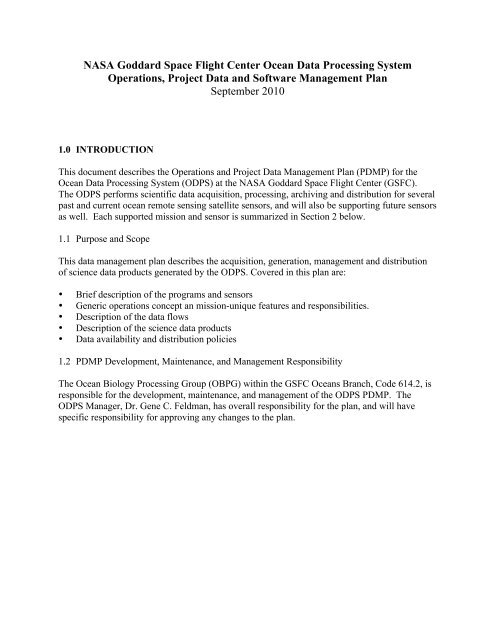

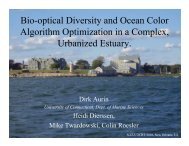
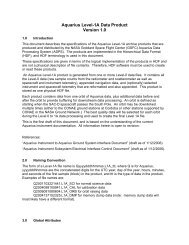
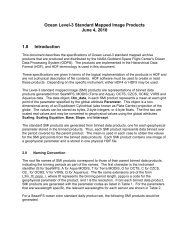
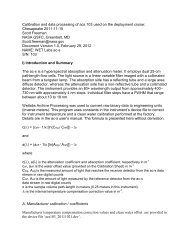
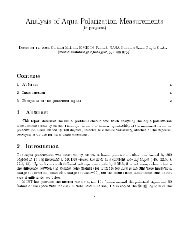
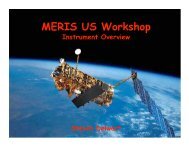
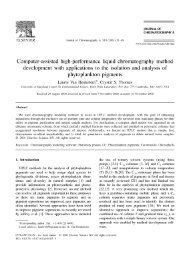
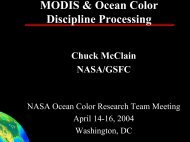
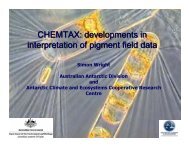
![Franz ocrt_terra_franz.ppt [Read-Only] - Ocean Color - NASA](https://img.yumpu.com/24076593/1/190x146/franz-ocrt-terra-franzppt-read-only-ocean-color-nasa.jpg?quality=85)

